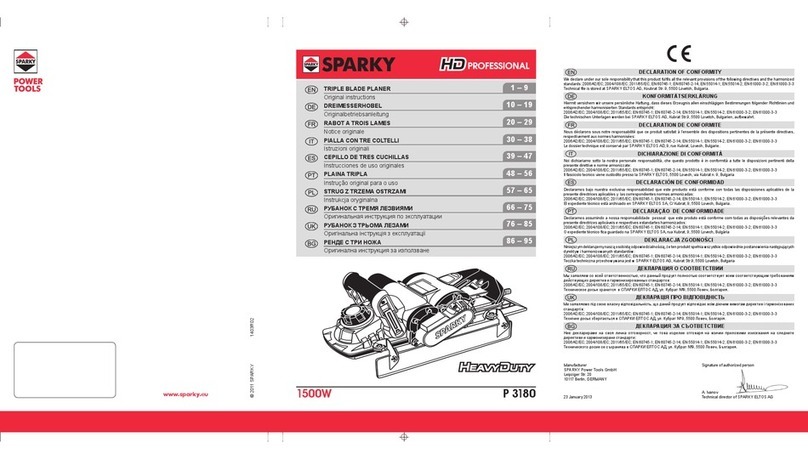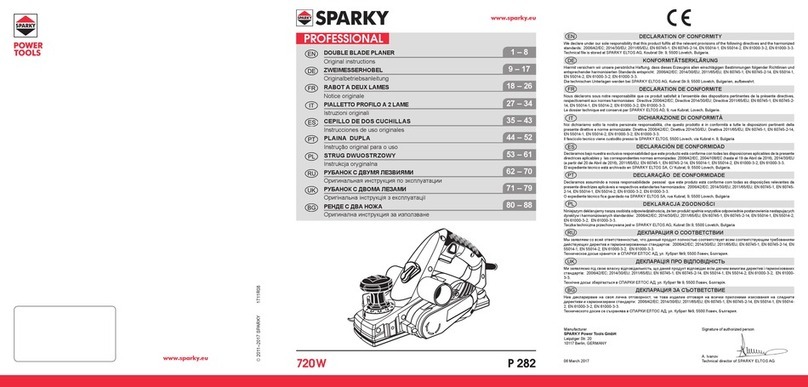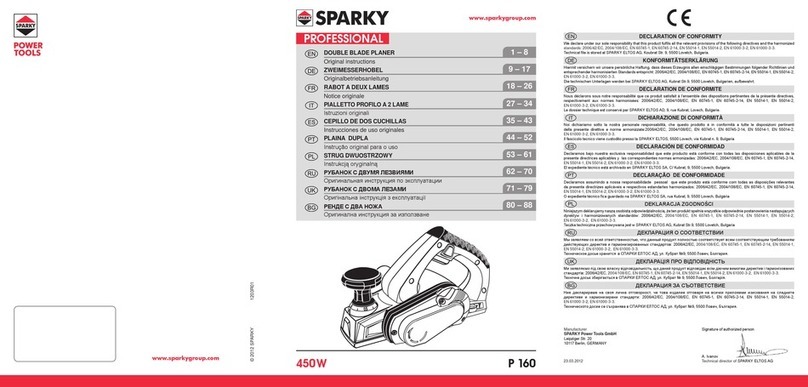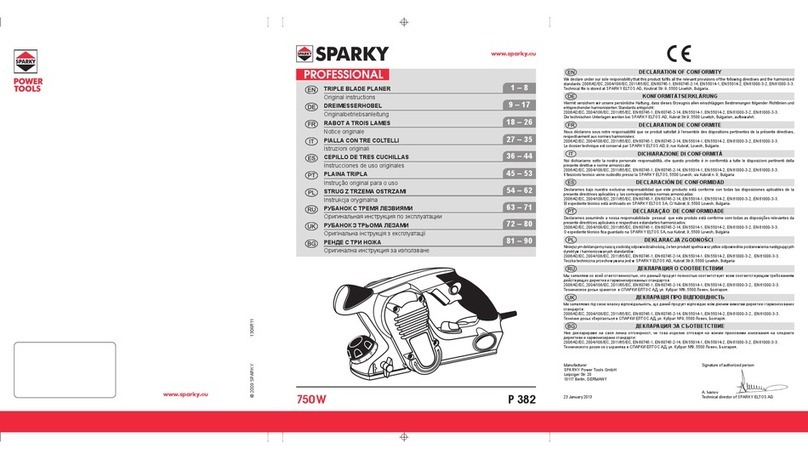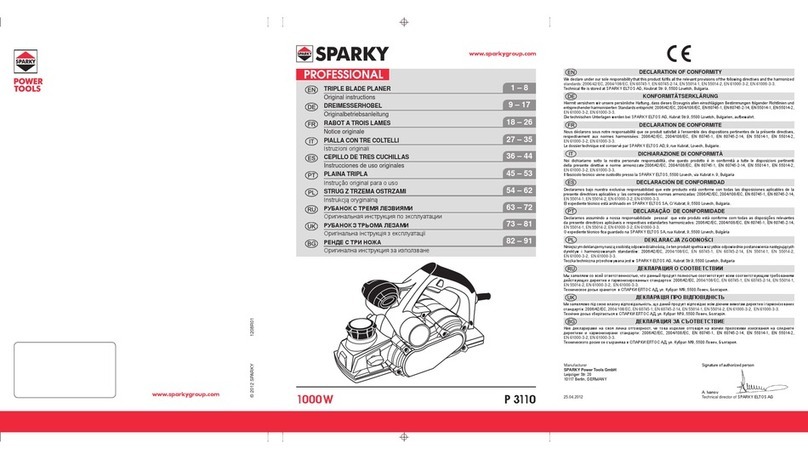4P 282EN
ƒ 'LVFRQQHFWWKHSOXJIURPWKHSRZHUVRXUFHEH-
fore making any adjustments, changing acces-
sories, or storing power tools. Such preventive
safety measures reduce the risk of starting the
power tool accidentally.
ƒ 6WRUHLGOHSRZHUWRROVRXWRIWKHUHDFKRIFKLO-
dren and do not allow persons unfamiliar with
the power tool or these instructions to operate
the power tool. Power tools are dangerous in
the hands of untrained users.
ƒ 0DLQWDLQSRZHUWRROV&KHFNIRU PLVDOLJQPHQW
or binding of moving parts, breakage of parts
and any other condition that may affect the
power tools operation. If damaged, have the
power tool repaired before use. Many accidents
are caused by poorly maintained power tools.
ƒ .HHS FXWWLQJ WRROV VKDUS DQG FOHDQ 3URSHUO\
maintained cutting tools with sharp cutting
edges are less likely to bind and are easier to
control.
ƒ 8VHWKHSRZHUWRRODFFHVVRULHVDQGWRROELWV
etc., in accordance with these instructions and
in the manner intended for the particular type
of power tool, taking into account the working
conditions and the work to be performed. Use
of the power tool for operations, different from
WKRVH LQWHQGHG FRXOG UHVXOW LQ D KD]DUGRXV
situation.
SERVICE
ƒ +DYH \RXU SRZHU WRRO VHUYLFHG E\ D TXDOLILHG
repair person using only identical replacement
parts. This will ensure that the safety of the
power tool is maintained.
IV - Additional safety rules
for electric planers
ƒ $OZD\VZHDUH\HDQGHDUSURWHFWLRQDQGXVHD
dust mask.
ƒ )XOO\ XQZLQG FDEOH GUXP H[WHQVLRQV WR DYRLG
potential overheating.
ƒ :KHQDQH[WHQVLRQFDEOHLVUHTXLUHG\RXPXVW
ensure that it has the right ampere rating for your
power tool and is in safe electrical condition.
ƒ $IWHUORQJZRUNLQJSHULRGVH[WHUQDOPHWDOSDUWV
and accessories could be hot.
ƒ ,ISRVVLEOHDOZD\VXVHFODPSVRUDYLFHWRKROG
your work.
ƒ$OZD\VVZLWFKRIIEHIRUH\RXSXWWKHSODQHU
down.
ƒ 'RQRWIRUFHWKHSODQHUOHWWKHWRROGRWKHZRUN
at a reasonable speed. Overloading will occur
if too much pressure is applied and the motor
slows resulting in inefficient planing and possi-
ble damage to the planer motor.
ƒ$OZD\VXVHDGXVWH[WUDFWLRQV\VWHPZKHUH
possible.
ƒ 5DJV FORWKV FRUG VWULQJ DQG WKH OLNH VKRXOG
never be left around the work area.
ƒ 5HPRYHDOOQDLOVVFUHZVDQGRWKHUREMHFWVIURP
the workpiece. You can damage the blade and
the tool by cutting into a nail or other foreign ob-
MHFW,WFDQDOVRSUHVHQWDVDIHW\KD]DUG
ƒ +DQGOHWKHEODGHVYHU\FDUHIXOO\
ƒ%HVXUHWKDWWKHEODGHLQVWDOODWLRQEROWVDUHVH-
curely tightened before operation.
ƒ +ROGWKHWRROILUPO\ZLWKERWKKDQGV
ƒ .HHSKDQGVDZD\IURPURWDWLQJSDUWV
ƒ%HIRUHXVLQJWKHWRRORQDQDFWXDOZRUNSLHFH
switch on and let it run for a while. Watch for
vibration or wobbling that could indicate poor
installation or a poorly balanced blade.
ƒ 0DNHVXUHWKDWDEODGHLVQRWLQFRQWDFWZLWKWKH
workpiece when you switch the machine on.
ƒ:DLWXQWLOWKHEODGHVDWWDLQIXOOVSHHGEHIRUH
cutting.
ƒ2SHUDWHWKHWRRODWOHDVWPPDZD\IURP
your face and body.
ƒ $OZD\VVZLWFKRIIDQGZDLWXQWLOWKHEODGHVKDYH
come to a complete standstill before attempting
any adjustments
ƒ 1HYHU VWLFN \RXU ILQJHU LQWR WKH FKLS FKXWH
Shavings may jam in the chute when cutting
damp wood. Clean out the chips with a stick but
only when the tool has been turned off and un-
plugged from the power point.
ƒ'RQRWOHDYHWKHPDFKLQHUXQQLQJXQDWWHQGHG
Operate the tool only when controlled by both
hands.
ƒ Leave the planer down only after the blade
barrel has come to a standstill. A moving
blade barrel of an unattended planer may catch
on a surface and thus cause loss of control and
serious injury.
ƒ :KHQOHDYLQJ WKH SODQHU VZLWFK RII DQGVHW LW
with the front base up on a wooden block so
that the blades are not in contact with anything.
ƒ $OZD\VFKDQJHERWKEODGHVDWWKHVDPHWLPH
otherwise the resulting imbalance will cause
vibration and shorten the blade and tool life.
WARNING:%HIRUHFRQQHFWLQJDWRRO
WR D SRZHU VRXUFH PDLQV VRFNHW SRZHU SRLQW
UHFHSWDFOH RXWOHW HWF EH VXUH WKDW WKH YROW-
age supply is the same as that specified on the
nameplate of the tool. A power source with a
voltage greater than that specified for the tool
can result in serious injury to the user, as well
as damage to the tool.
pages-P282.indd 4 ɝ






